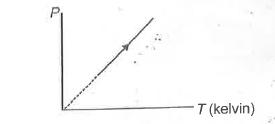Two ideal gas thermometer A and B use oxygen and hydrogen respectively . The following observations are made:
Temperature,
Pressure therometer A,
Pressure therometer B
Triple point of water,
1.250×105Pa,
0.200×105Pa
Normal melting point of sulphur, 1.797×105Pa,
0.287×105Pa
(a) What is the absolute temperature of normal melting point of sulphur as read by thermometers A and B ?
(b) What do you think is the reason for the slightly different answers from A and B ? (The thermometers are not faulty). what further procedure is needed in the experiment to reduce the discrepancy between the two readings.
To solve the problem, we will calculate the absolute temperature of the normal melting point of sulfur as read by thermometers A and B using the ideal gas law. We will also discuss the reasons for the discrepancy in readings and suggest a procedure to reduce this discrepancy.
1. Using the Ideal Gas Law Relation:
From the ideal gas law, we know that pressure is directly proportional to temperature when volume and the number of moles are constant:
P1T1=P2T2
Rearranging gives:
T2=T1⋅P2P1
2. For Thermometer A:
- Let TM be the temperature at the normal melting point of sulfur.
- Using the pressures:
TM=TTR⋅PMPTR
Substituting the values:
TM=273.16⋅1.797×1051.250×105
TM=273.16⋅1.4376≈392.69K
3. For Thermometer B:
- Similarly, we calculate:
TM=TTR⋅PMPTR
Substituting the values:
TM=273.16⋅0.287×1050.200×105
TM=273.16⋅1.435≈391.98K
(b) Reason for Discrepancy and Further Procedure:
1. Reason for Discrepancy:
The slight difference in readings from thermometers A and B arises because oxygen and hydrogen do not behave as perfect ideal gases under all conditions. The ideal gas law assumes that gas particles do not interact and occupy no volume, which is not entirely true for real gases, especially under varying temperature and pressure conditions.
2. Further Procedure to Reduce Discrepancy:
To minimize the discrepancies between the two readings, the experiment should be conducted at low temperatures and high pressures. Under these conditions, real gases behave more like ideal gases, leading to more accurate and consistent readings across different types of thermometers.
Summary of Results:
- Absolute temperature of normal melting point of sulfur as read by thermometer A: 392.69 K
- Absolute temperature of normal melting point of sulfur as read by thermometer B: 391.98 K
- Discrepancy is due to the non-ideal behavior of gases; using low temperature and high pressure can reduce this discrepancy.
From the ideal gas law, we know that pressure is directly proportional to temperature when volume and the number of moles are constant:
P1T1=P2T2
Rearranging gives:
T2=T1⋅P2P1
- Let TM be the temperature at the normal melting point of sulfur.
- Using the pressures:
TM=TTR⋅PMPTR
Substituting the values:
TM=273.16⋅1.797×1051.250×105
TM=273.16⋅1.4376≈392.69K
- Similarly, we calculate:
TM=TTR⋅PMPTR
Substituting the values:
TM=273.16⋅0.287×1050.200×105
TM=273.16⋅1.435≈391.98K
The slight difference in readings from thermometers A and B arises because oxygen and hydrogen do not behave as perfect ideal gases under all conditions. The ideal gas law assumes that gas particles do not interact and occupy no volume, which is not entirely true for real gases, especially under varying temperature and pressure conditions.
To minimize the discrepancies between the two readings, the experiment should be conducted at low temperatures and high pressures. Under these conditions, real gases behave more like ideal gases, leading to more accurate and consistent readings across different types of thermometers.
- Absolute temperature of normal melting point of sulfur as read by thermometer A: 392.69 K
- Absolute temperature of normal melting point of sulfur as read by thermometer B: 391.98 K
- Discrepancy is due to the non-ideal behavior of gases; using low temperature and high pressure can reduce this discrepancy.
Topper's Solved these Questions
- THERMAL PROPERTIES OF MATTERBook:NCERT ENGLISHChapter:THERMAL PROPERTIES OF MATTERExercise:EXERCISE
Explore 22 Videos
- SYSTEMS OF PARTICLES AND ROTATIONAL MOTIONBook:NCERT ENGLISHChapter:SYSTEMS OF PARTICLES AND ROTATIONAL MOTIONExercise:EXERCISE
Explore 33 Videos
- THERMODYNAMICSBook:NCERT ENGLISHChapter:THERMODYNAMICSExercise:EXERCISE
Explore 10 Videos
Similar Questions
Knowledge Check
If the pressure and the volume of certain quantity of ideal gas are halved, then its temperature
Ais doubledBbecomes one-fourthCremains constantDbecome four times
Mercury thermometers can be used to measure temperatures upto
View SolutionThe observed pressure of real gas is more than the ideal pressure.
View SolutionThe pressure of the gas in a constant volume gas thermometer is 70 kPa at the ice point. Find the pressure at the steam point.
View SolutionThe graph of pressure and temperature for an ideal gas is as shown in figure. The given process is

View SolutionTemperature can be measured using a ............(beam balance/thermometer)
View SolutionTemperature of an ideal gas increases in:
View SolutionAn ideal gas undergoing adiabatic change has the following pressure-temperature relationship
View Solution